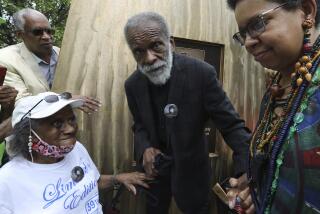Wisconsin Exhibit to Honor Frank Lloyd Wright
- Share via
MADISON, Wis. — Controversial architect Frank Lloyd Wright is about to be honored on the University of Wisconsin campus by an exhibition expected to draw visitors from around the world.
Wright was born near Madison in the village of Richland Center on June 8, 1867. Before his death in Arizona in 1959 at age 92, Wright spent eight decades creating architectural masterpieces ranging from lake cottages and boat houses to futuristic private homes, the Guggenheim Museum in New York and the old Imperial Hotel in Tokyo.
For generations of Southern Californians, the Frank Lloyd Wright School of Architecture at Taliesin West near Scottsdale, Ariz., has been a highlight of winter travel along the Sun Circuit.
Roots of Genius
But much of his life was focused close to his Taliesin East home and School of Architecture in Spring Green near Madison. This area showcases the roots and scope of his creative genius.
For several years the Elvehjem (pronounced L-V-M) Museum at University of Wisconsin has been researching Wright’s lifework to bring into full perspective 32 Frank Lloyd Wright architectural treasures, created in and around Madison from 1893 into the late 1930s.
Now the largest-ever exhibition capsuling the creativity of his career is in final preparation for display at the museum from Sept. 2 to Nov. 6.
The exhibit is entitled “Frank Lloyd Wright and Madison: Eight Decades of Artistic and Social Interaction.” Many original drawings never before shown to public will be on display. It is planned as an exhibit to increase worldwide awareness and understanding of his nearly 500 architectural landmarks, as well as all of the designs that continue to be created by student architects and their instructors, from May to October at Taliesin East and during the winter at Taliesin West.
His Life and Work
Our visit to the museum to preview preparations for the exhibit has shown us how Wright’s life and work connect the capital city of Madison, the town of Spring Green and Taliesin East, separated by only 40 miles.
The drive of less than an hour from the university campus to Spring Green can lead to a four-seasons resort, as well as to the Wright home and architectural fellowship.
We joined a guided tour through the Hillside Home School at Taliesin East, where student apprentice architects from many nations are at work on their drafting boards, creating concepts in homes and public buildings while guided by Wright’s vision of organic architecture that melds a design into its natural surroundings.
Taliesin means “shining brow” in Welsh, the language of Wright’s ancestors. His father was a preacher, a music composer and teacher. His mother was an educator, and her Welsh family acquired considerable property after immigrating; 600 acres of this property are the grounds of Taliesin East.
Progressive School
After his studies at the University of Wisconsin and apprenticeship years in Chicago, Wright created an American architectural style and received worldwide recognition by the time he returned to build his Taliesin home in 1911. He had previously built the Hillside Home School on that property for two of his aunts, who operated one of the nation’s first progressive co-ed boarding schools. In 1932, Wright and his third wife, Olgivanna, transformed Hillside into what is now the Wisconsin campus of the Frank Lloyd Wright School of Architecture.
Created of native oak and sandstone on a wooded slope, the Hillside Home School takes visitors into its drafting studio, living and dining areas and a small theater.
Here a visitor can observe the way 35 student apprentices work with 35 faculty architects. The same students and faculty move to the Taliesin West winter campus.
Lovers’ Windmill
The Wright home is close to the Hillside school and is open for special occasions. His Romeo and Juliet Windmill rises through the trees above Taliesin and the valley, through which the Wisconsin River flows. The waterfall he created splashes and churns near the home and school.
The Taliesin East property has been designated a National Historic Landmark, as has Taliesin West, which the Wrights founded in 1937 on 600 acres along the southerly slope of Arizona’s McDowell Range.
The resort is centered two miles from the Wright Foundation property around the Wisconsin River, the village of Spring Green and its sheltering hills.
Spring Green restaurant, opened in 1967, is the only restaurant Frank Lloyd Wright designed. The beamed interior of the dining area complements the vistas of the valley. Specialties include Lake Superior whitefish, chicken Christopher stuffed with crab meat and veal a la maison.
Despite the drought in the Midwest, the Wisconsin River still ripples through the valley between wide sandy beaches. We watched canoeists and sunbathers in the summer sunshine. Canoe and fishing boat rentals are available.
Challenging Golf Course
The Springs Golf Course, designed by Robert Trent Jones, curves challengingly through the wooded hillsides; it has been rated by Golf Digest as one of the top 50 public courses in the nation.
Wintergreen Ski Center is half a mile from the Spring Green restaurant. Two double chairs and a J-bar lift serve nine runs from beginner to expert down a vertical drop of 400 feet.
Groomed cross-country trails cover 1,200 acres of the kind of terrain that Wright wandered as a boy. Nearby is a farm where he once worked. Horses at Spring Green stables make valley and hillside treks possible. You can often spot deer and wild turkey in groves of birch, pine and oak.
Three miles from Spring Green village, American Players Theater performs Shakespeare and other classics on an outdoor stage from mid-June through mid-December.
Nine miles from Spring Green, the House on the Rock is a fantasy built by Alex Jordan atop a 450-foot rock chimney. It’s been featured on national TV and draws more than 500,000 visitors every year to its imaginative mix of music machines, pipe organs, a Main Street of yesteryear and the world’s largest carrousel.
Spring Green offers accommodations in such architectural classics as the 45-room Round Barn designed by a Wright associate. A new suite, including Jacuzzi and indoor and outdoor pools, is about $80 a night.
Traditional Hospitality
The bar and outdoor garden at Spring Green’s Post House restaurant were designed by William Wesley Peters, son-in-law of the Wrights and chairman of the Frank Lloyd Wright Foundation. The restaurant, which has a tradition of 130 years of dining hospitality, features a Dutch kitchen.
Visiting the Bank of Spring Green can also be an architectural adventure. William Wesley Peters was its chief architect.
A special House Beautiful display will express Wright’s belief that every person has “a right to create an environment in which beauty, happiness, dignity and self-worth can be achieved.”
Among many satellite events, Taliesin Fellowship Musicians will present a concert Sept. 11. Newly discovered compositions by Frank Lloyd Wright’s father will be performed at Madison’s Old Music Hall Sept. 16-17.
This year, Madison becomes more than ever a “Europe of the Midwest” during this renaissance in Frank Lloyd Wright interest. It’s a city of five lakes built on an isthmus and surrounded by German, Swiss and Norwegian communities. Cruising, paddling and rowing on the waters is complemented by bicycle paths through the city, the mile-long pedestrian mall from the university to the state capitol, and walking the Saturday open-air market around the capitol.
We helped create the mood for our return to Madison and the Wright story by staying close to the capitol, the university and Lake Mendota at Mansion Hill Inn, a gabled 1858 Romanesque Revival mansion. One-bedroom units start at $80, suites at $170; phone (608) 255-3999. One evening we dined on classic French cuisine at L’Etoile overlooking Capitol Square, and another at Quivey’s Grove in a four-acre country estate on Nesbitt Road, south of the Beltline.
For more information on the Frank Lloyd Wright exhibit and travel to Wisconsin, contact the Wisconsin Division of Tourism, P.O. Box 7606, Madison, Wis. 53707, (608) 266-2161.
More to Read
Sign up for The Wild
We’ll help you find the best places to hike, bike and run, as well as the perfect silent spots for meditation and yoga.
You may occasionally receive promotional content from the Los Angeles Times.






